A Big Data Method Based on Random BP Neural Network and Its Application for Analyzing Influencing Factors on Productivity of Shale Gas Wells
Abstract
:1. Introduction
- (1)
- We are the first to analyze the impact of different address characteristics and engineering parameters on gas well capacity by taking advantage of big data and artificial intelligence.
- (2)
- To better analyze the effect of different parameters on gas well capacity, we designed a random BP neural network analysis method, which can effectively learn the effect of different parameters on capacity.
- (3)
- With extensive experiments on real data, our method can effectively and intuitively reflect the influence of different factors on capacity and calculate the optimal parameters.
2. Materials and Methods
2.1. Limitations of Conventional Methods
2.1.1. Statistical Method
2.1.2. BP Neural Network Analysis
2.2. Random BP Neural Network Analysis
2.2.1. Basic Ideas
2.2.2. Analysis Method
Random BP Network Modeling
Data Prediction Analysis
3. Results and Discussion
3.1. Network Modeling with Big Data
3.2. Analysis of Factors Affecting Well Productivity
3.3. Advantages of the Method Proposed in the Paper
4. Conclusions
5. Parameter Description
Author Contributions
Funding
Institutional Review Board Statement
Informed Consent Statement
Data Availability Statement
Conflicts of Interest
References
- Zou, C.; Zhao, Q.; Cong, L.; Wang, H.; Shi, Z.S.; Wu, J.; Pan, S. Development progress, potential and prospect of shale gas in China. Nat. Gas Ind. 2021, 41, 1–14. [Google Scholar]
- Xinhua, M.A.; Jun, X.I.E.; Rui, Y.O.N.G.; Yiqing, Z.H.U. Geological characteristics and high production control factors of shale gas reservoirs in Silurian Longmaxi Formation, southern Sichuan Basin, SW China. Pet. Explor. Dev. 2020, 47, 901–915. [Google Scholar]
- Li, Y.; Zhou, D.H.; Wang, W.H.; Jiang, T.X.; Xue, Z.J. Development of unconventional gas and technologies adopted in China. Energy Geosci. 2020, 1, 55–68. [Google Scholar] [CrossRef]
- Deng, Y.; Chen, Q. Using artificial neural network to realize type curve match analysis of well test data. Pet. Explor. Dev. 2000, 27, 64–66. [Google Scholar]
- Asadisaghandi, J.; Tahmasebi, P. Comparative evaluation of back-propagation neural network learning algorithms and empirical correlations for prediction of oil PVT properties in Iran oilfields. J. Pet. Sci. Eng. 2011, 78, 464–475. [Google Scholar] [CrossRef]
- Memon, P.Q.; Yong, S.P.; Pao, W.; Pau, J.S. Dynamic well bottom-hole flowing pressure prediction based on radial basis neural network. In Science and Information Conference; Springer: Cham, Switerland, 2014; pp. 279–292. [Google Scholar]
- Zhang, D.; Yuntian, C.H.E.N.; Jin, M.E.N.G. Synthetic well logs generation via Recurrent Neural Networks. Pet. Explor. Dev. 2018, 45, 629–639. [Google Scholar] [CrossRef]
- Daolun, L.I.; Xuliang, L.I.U.; Wenshu, Z.H.A.; Jinghai, Y.A.N.G.; Detang, L.U. Automatic well test interpretation based on convolutional neural network for a radial composite reservoir. Pet. Explor. Dev. 2020, 47, 623–631. [Google Scholar]
- Wang, H.; Shi, Z.; Sun, S. Biostratigraphy and reservoir characteristics of the Ordovician Wufeng-Silurian Longmaxi shale in the Sichuan Basin and surrounding areas, China. Pet. Explor. Dev. 2021, 48, 879–890. [Google Scholar] [CrossRef]
- Zhao, J.; Ren, L.; Shen, C.; Li, Y. Latest research progresses in network fracturing theories and technologies for shale gas reservoirs. Nat. Gas Ind. B 2018, 5, 533–546. [Google Scholar] [CrossRef]
- Wei, M.; Duan, Y.; Dong, M.; Fang, Q.; Dejam, M. Transient production decline behavior analysis for a multi-fractured horizontal well with discrete fracture networks in shale gas reservoirs. J. Porous Media 2019, 22, 343–361. [Google Scholar] [CrossRef]
- Liang, X. Characteristics and significance of sedimentary facies of Wufeng–Longmaxi shale in Weirong shale gas field, Southern Sichuan Basin. Pet. Geol. Exp. 2019, 41, 326–332. [Google Scholar]
- Zhao, Y.; Lu, G.; Zhang, L.; Wei, Y.; Guo, J.; Chang, C. Numerical simulation of shale gas reservoirs considering discrete fracture network using a coupled multiple transport mechanisms and geomechanics model. J. Pet. Sci. Eng. 2020, 195, 107588. [Google Scholar] [CrossRef]
- Jaffe, K.; Ter Horst, E.; Gunn, L.H.; Zambrano, J.D.; Molina, G. A network analysis of research productivity by country, discipline, and wealth. PLoS ONE 2020, 15, e0232458. [Google Scholar] [CrossRef] [PubMed]
- Xu, J.; Yang, L.; Liu, Z.; Ding, Y.; Gao, R.; Wang, Z.; Mo, S. A New Approach to Embed Complex Fracture Network in Tight Oil Reservoir and Well Productivity Analysis. Nat. Resour. Res. 2021, 30, 2575–2586. [Google Scholar] [CrossRef]
- Wang, M.; Feng, C. Regional total-factor productivity and environmental governance efficiency of China’s industrial sectors: A two-stage network-based super DEA approach. J. Clean. Prod. 2020, 273, 123110. [Google Scholar] [CrossRef]
- Syed, F.I.; Muther, T.; Dahaghi, A.K.; Negahban, S. AI/ML assisted shale gas production performance evaluation. J. Pet. Explor. Prod. Technol. 2021, 11, 3509–3519. [Google Scholar] [CrossRef]
- Ansari, A.; Fathi, E.; Belyadi, F.; Takbiri-Borujeni, A.; Belyadi, H. Data-based smart model for real time liquid loading diagnostics in Marcellus Shale via machine learning. In Proceedings of the SPE Canada Unconventional Resources Conference, Calgary, AB, Canada, 13–14 March 2018. [Google Scholar]
- Asala, H.I.; Chebeir, J.; Zhu, W.; Gupta, I.; Taleghani, A.D.; Romagnoli, J. A machine learning approach to optimize shale gas supply chain networks. In Proceedings of the SPE Annual Technical Conference and Exhibition, San Antonio, TX, USA, 9–11 October 2017. [Google Scholar]
- Calderón-Macías, C.; Sen, M.K.; Stoffa, P.L. Artificial neural networks for parameter estimation in geophysics [Link]. Geophys. Prospect. 2000, 48, 21–47. [Google Scholar] [CrossRef]
- Shimelevich, M.I.; Obornev, E.A.; Obornev, I.E.; Rodionov, E.A. The neural network approximation method for solving multidimensional nonlinear inverse problems of geophysics. Izv. Phys. Solid Earth 2017, 53, 588–597. [Google Scholar] [CrossRef]
- Xiong, W.; Ji, X.; Ma, Y.; Wang, Y.; AlBinHassan, N.M.; Ali, M.N.; Luo, Y. Seismic fault detection with convolutional neural network. Geophysics 2018, 83, O97–O103. [Google Scholar] [CrossRef]
- Wang, Y.; Ge, Q.; Lu, W.; Yan, X. Well-logging constrained seismic inversion based on closed-loop convolutional neural network. IEEE Trans. Geosci. Remote Sens. 2020, 58, 5564–5574. [Google Scholar] [CrossRef]
- Zhu, L.; Zhang, C.; Zhang, C.; Wei, Y.; Zhou, X.; Cheng, Y.; Zhang, L. Prediction of total organic carbon content in shale reservoir based on a new integrated hybrid neural network and conventional well logging curves. J. Geophys. Eng. 2018, 15, 1050–1061. [Google Scholar] [CrossRef] [Green Version]
- Zeng, L.; Ren, W.; Shan, L.; Huo, F. Well logging prediction and uncertainty analysis based on recurrent neural network with attention mechanism and Bayesian theory. J. Pet. Sci. Eng. 2022, 208, 109458. [Google Scholar] [CrossRef]
- Wang, H. Discrete fracture networks modeling of shale gas production and revisit rate transient analysis in heterogeneous fractured reservoirs. J. Pet. Sci. Eng. 2018, 169, 796–812. [Google Scholar] [CrossRef]
- Faelens, L.; Hoorelbeke, K.; Fried, E.; De Raedt, R.; Koster, E.H. Negative influences of Facebook use through the lens of network analysis. Comput. Hum. Behav. 2019, 96, 13–22. [Google Scholar] [CrossRef] [Green Version]
- Duong, A.N. Rate-decline analysis for fracture-dominated shale reservoirs. SPE Reserv. Eval. Eng. 2011, 14, 377–387. [Google Scholar] [CrossRef] [Green Version]
- Feng, Z. Preliminary discussion on the Lower Ordovician lithofacies and paleogeography in north China. J. East China Pet. Inst. 1977, 19, 57–79. [Google Scholar]
- Xiangdong, H.; Shaoqing, W. Prediction of bottom-hole flow pressure in coalbed gas wells based on GA optimization SVM. In Proceedings of the 2018 IEEE 3rd Advanced Information Technology, Electronic and Automation Control Conference (IAEAC), Chongqing, China, 12–14 October 2018; pp. 138–141. [Google Scholar]
- Li, X.; Xiao, K.; Li, X.; Yu, C.; Fan, D.; Sun, Z. A well rate prediction method based on LSTM algorithm considering manual operations. J. Pet. Sci. Eng. 2021, 210, 110047. [Google Scholar] [CrossRef]
- Shi, Y.; Song, X.; Song, G. Productivity prediction of a multilateral-well geothermal system based on a long short-term memory and multi-layer perceptron combinational neural network. Appl. Energy 2021, 282, 116046. [Google Scholar] [CrossRef]
- Wright, R.E. Logistic regression. In Reading and Understanding Multivariate Statistics; American Psychological Association: Washington, DC, USA, 1995. [Google Scholar]
- Awad, M.; Khanna, R. Support vector regression. In Efficient Learning Machines; Apress: Berkeley, CA, USA, 2015; pp. 67–80. [Google Scholar]
- Olah, C. Understanding LSTM Networks. 2015. Available online: https://colah.github.io/posts/2015-08-Understanding-LSTMs/ (accessed on 28 February 2022).
- LeCun, Y.; Bottou, L.; Bengio, Y.; Haffner, P. Gradient-based learning applied to document recognition. Proc. IEEE 1998, 86, 2278–2324. [Google Scholar] [CrossRef] [Green Version]
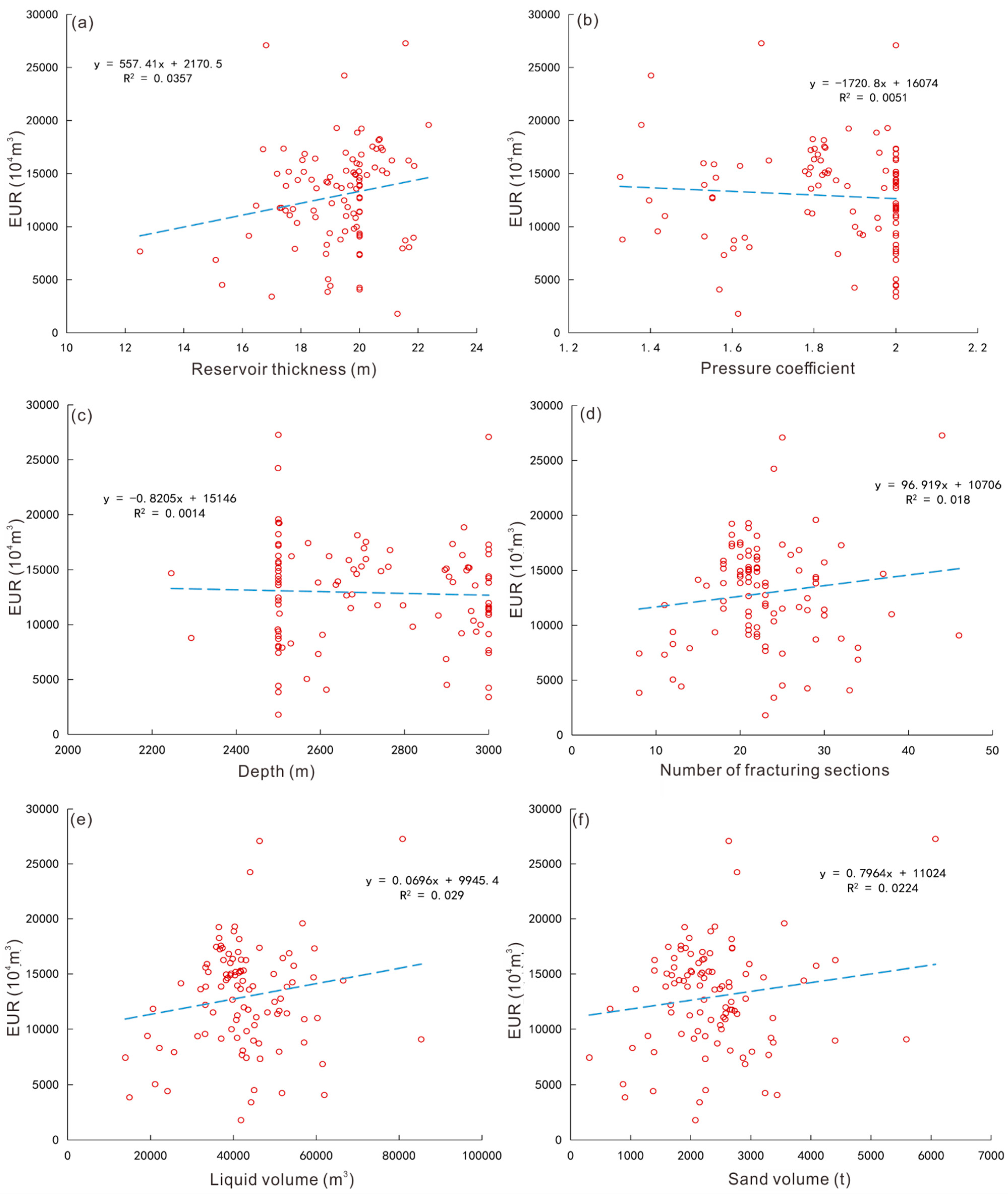
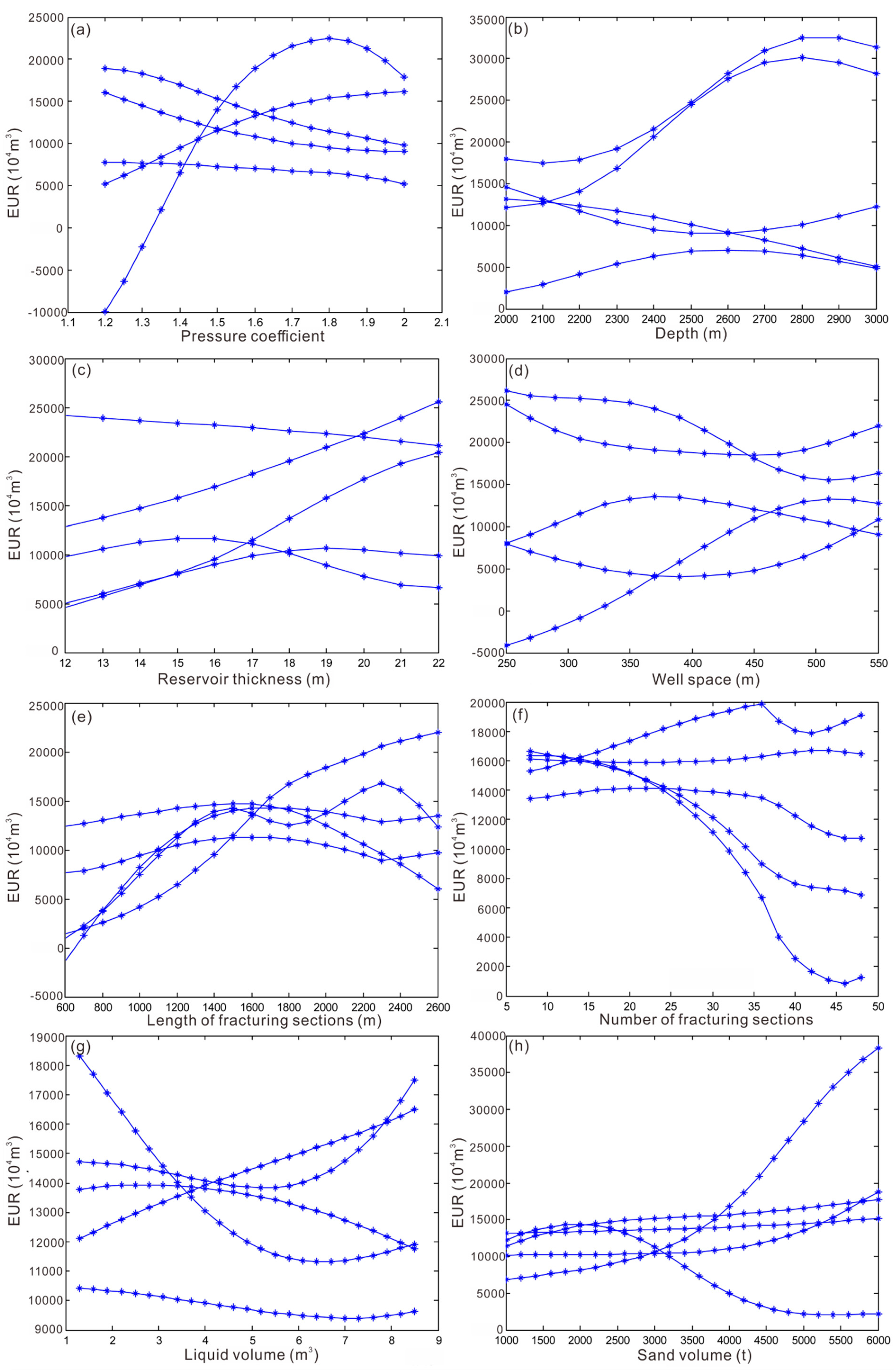
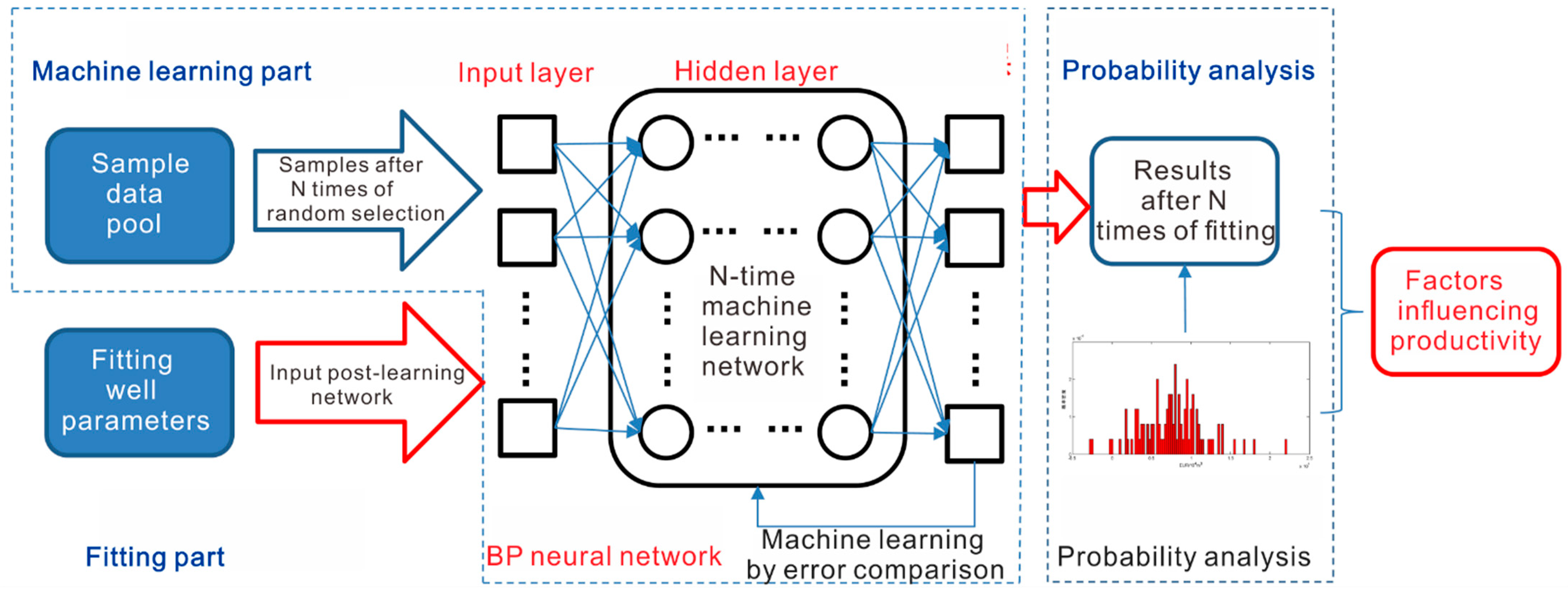
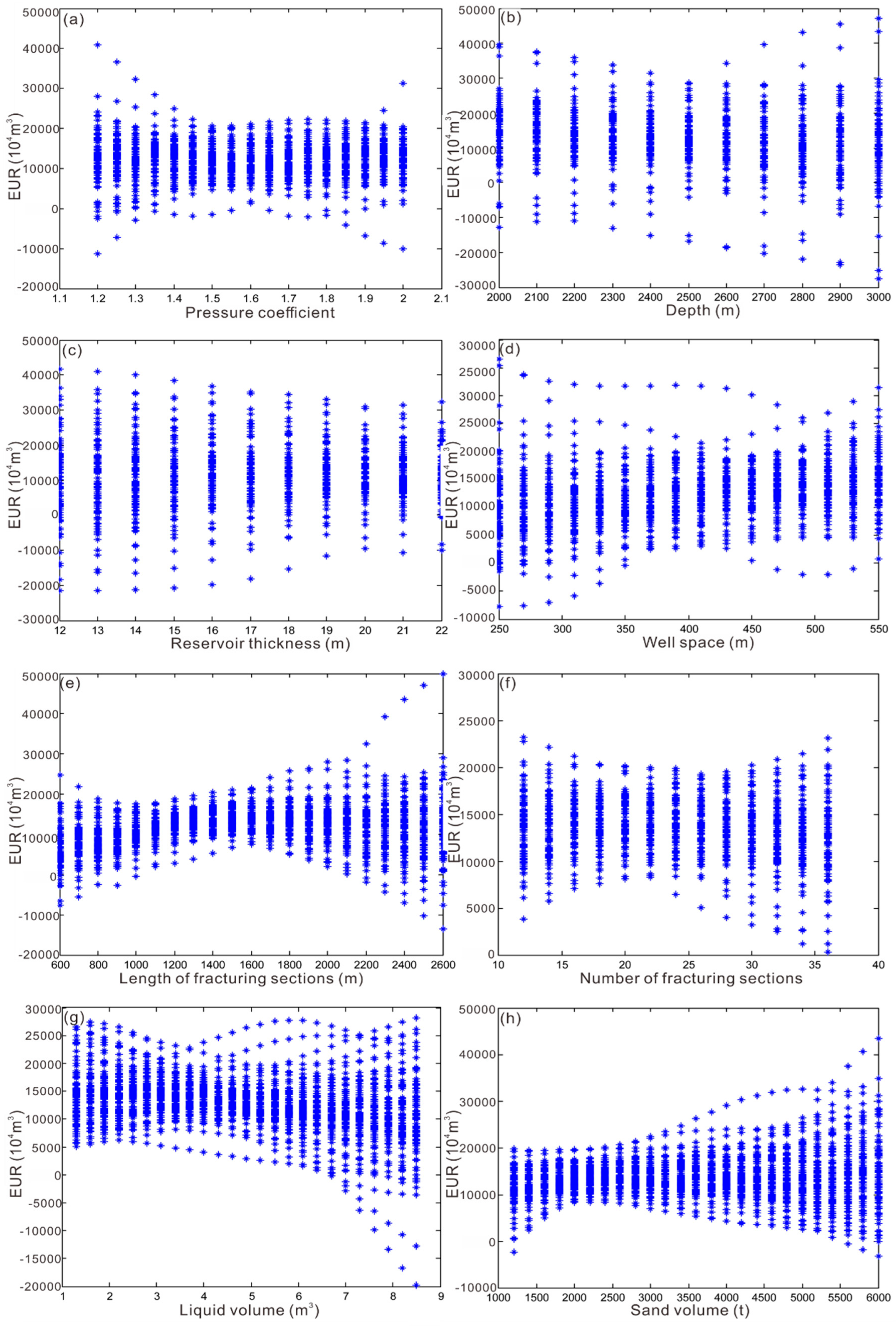

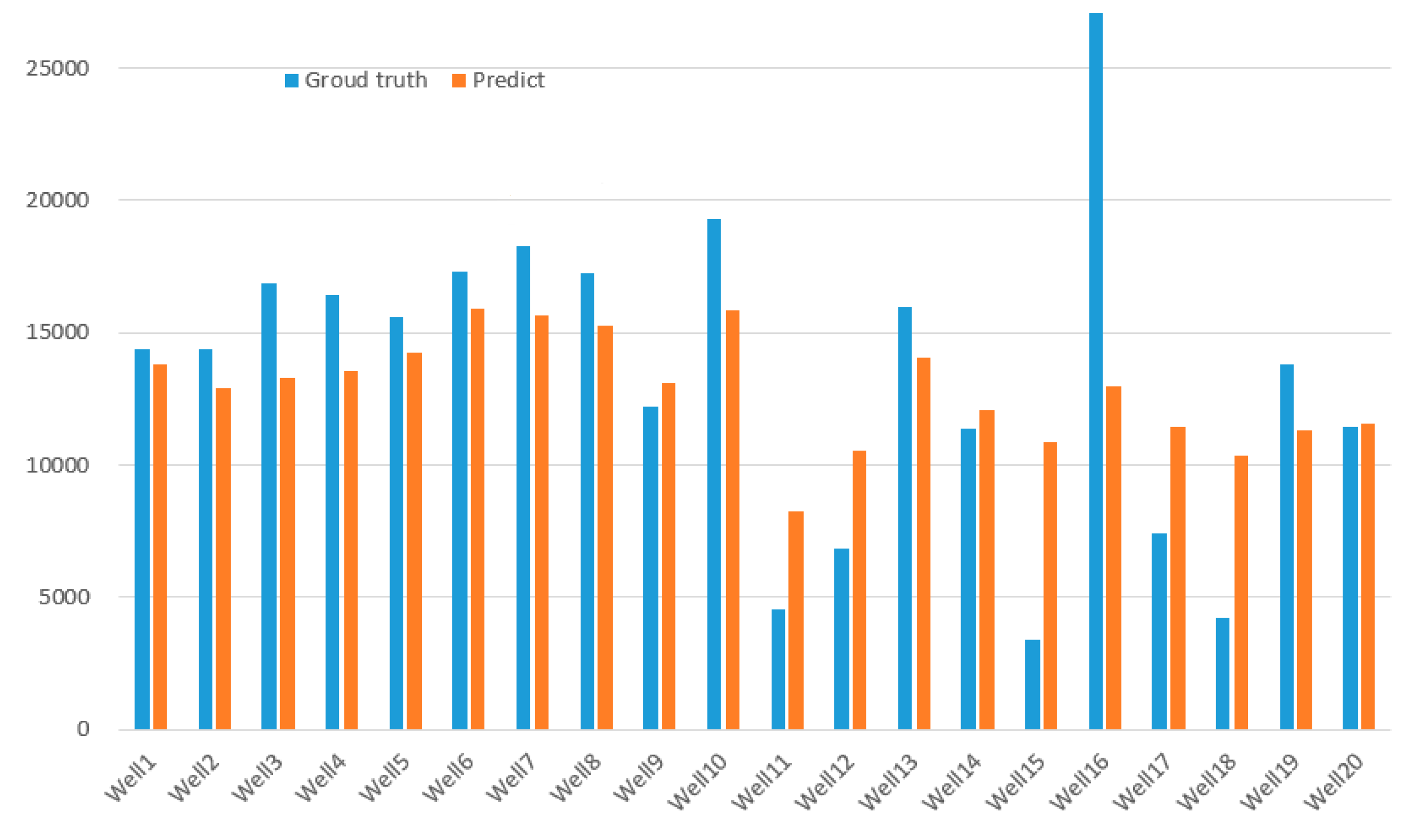
| Ground Truth | Prediction | Lower Limit of 50% Confidence | Upper Limit of 50% Confidence | |
|---|---|---|---|---|
| Well 1 | 14,372 | 13,783 | 13,644 | 13,923 |
| Well 2 | 14,399 | 12,910 | 12,672 | 13,148 |
| Well 3 | 16,863 | 13,267 | 13,078 | 13,456 |
| Well 4 | 16,423 | 13,574 | 13,371 | 13,777 |
| Well 5 | 15,588 | 14,268 | 14,113 | 14,422 |
| Well 6 | 17,338 | 15,883 | 15,732 | 16,035 |
| Well 7 | 18,247 | 15,625 | 15,473 | 15,777 |
| Well 8 | 17,218 | 15,269 | 15,116 | 15,421 |
| Well 9 | 12,201 | 13,100 | 12,938 | 13,263 |
| Well 10 | 19,293 | 15,865 | 15,688 | 16,042 |
| Well 11 | 4517 | 8215 | 7882 | 8548 |
| Well 12 | 6866 | 10,557 | 10,218 | 10,897 |
| Well 13 | 15,983 | 14,074 | 13,904 | 14,243 |
| Well 14 | 11,378 | 12,066 | 11,903 | 12,228 |
| Well 15 | 3412 | 10,894 | 10,465 | 11,323 |
| Well 16 | 27,089 | 12,950 | 12,482 | 13,418 |
| Well 17 | 7424 | 11,417 | 11,202 | 11,632 |
| Well 18 | 4255 | 10,381 | 10,128 | 10,633 |
| Well 19 | 13,830 | 11,341 | 11,113 | 11,569 |
| Well 20 | 11,428 | 11,575 | 11,341 | 11,808 |
| Models | MAE |
|---|---|
| LR | 6823 |
| SVR | 6507 |
| LSTM | 3612 |
| CNN | 4526 |
| Our method | 3228 |
Publisher’s Note: MDPI stays neutral with regard to jurisdictional claims in published maps and institutional affiliations. |
© 2022 by the authors. Licensee MDPI, Basel, Switzerland. This article is an open access article distributed under the terms and conditions of the Creative Commons Attribution (CC BY) license (https://creativecommons.org/licenses/by/4.0/).
Share and Cite
Zhao, Q.; Zhang, L.; Liu, Z.; Wang, H.; Yao, J.; Zhang, X.; Yu, R.; Zhou, T.; Kang, L. A Big Data Method Based on Random BP Neural Network and Its Application for Analyzing Influencing Factors on Productivity of Shale Gas Wells. Energies 2022, 15, 2526. https://doi.org/10.3390/en15072526
Zhao Q, Zhang L, Liu Z, Wang H, Yao J, Zhang X, Yu R, Zhou T, Kang L. A Big Data Method Based on Random BP Neural Network and Its Application for Analyzing Influencing Factors on Productivity of Shale Gas Wells. Energies. 2022; 15(7):2526. https://doi.org/10.3390/en15072526
Chicago/Turabian StyleZhao, Qun, Leifu Zhang, Zhongguo Liu, Hongyan Wang, Jie Yao, Xiaowei Zhang, Rongze Yu, Tianqi Zhou, and Lixia Kang. 2022. "A Big Data Method Based on Random BP Neural Network and Its Application for Analyzing Influencing Factors on Productivity of Shale Gas Wells" Energies 15, no. 7: 2526. https://doi.org/10.3390/en15072526
APA StyleZhao, Q., Zhang, L., Liu, Z., Wang, H., Yao, J., Zhang, X., Yu, R., Zhou, T., & Kang, L. (2022). A Big Data Method Based on Random BP Neural Network and Its Application for Analyzing Influencing Factors on Productivity of Shale Gas Wells. Energies, 15(7), 2526. https://doi.org/10.3390/en15072526






